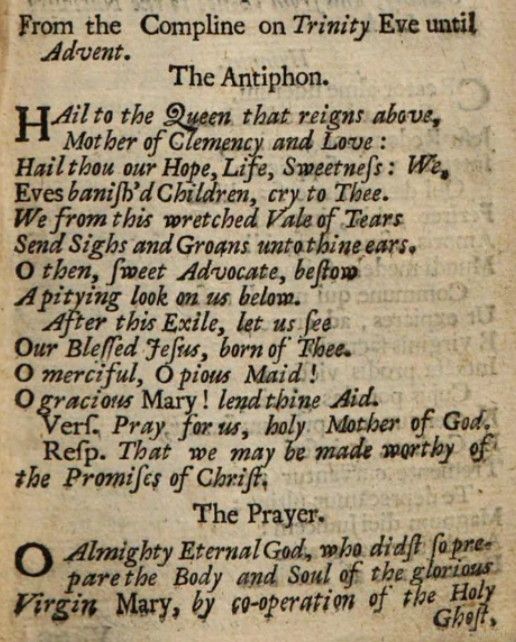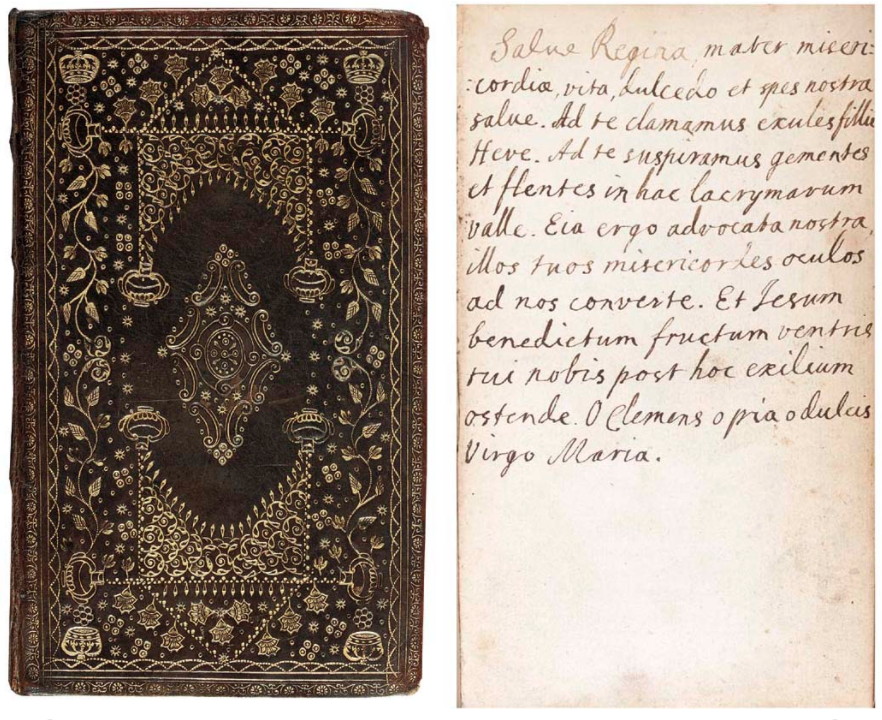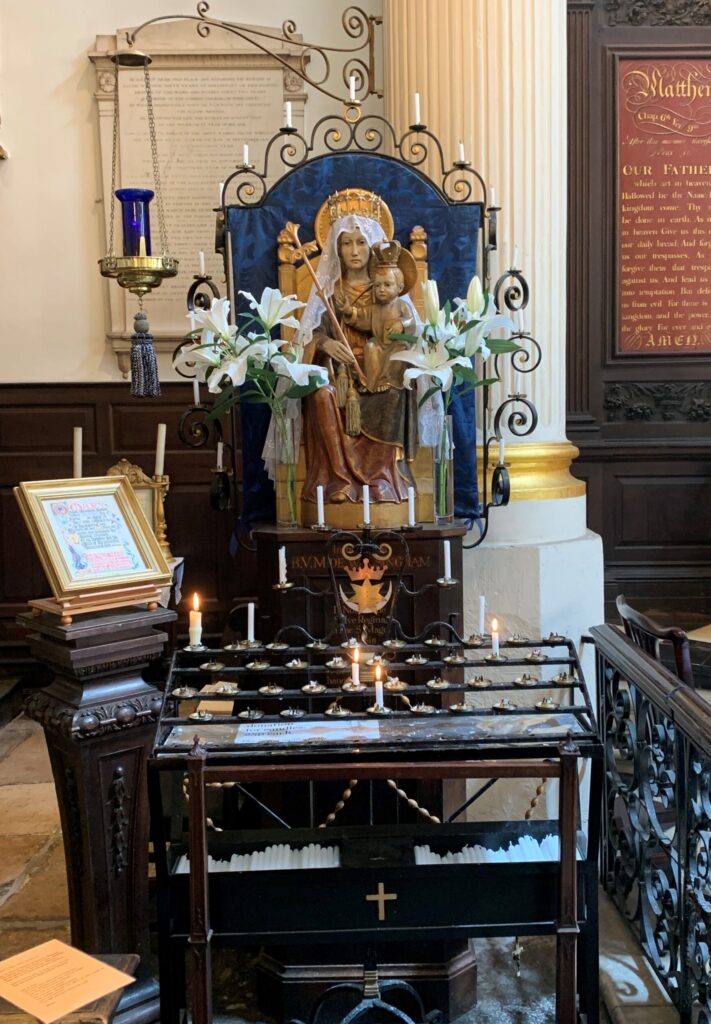
The Statue of Our Lady of Walsingham, where the office of the Fraternity of Our Lady de Salve Regina is offered and the Angelus or Regina Caeli is sung after Sunday Mass, is the work of Martin Travers. It was adapted from the early 13th-century Langham Madonna in the Victoria and Albert Museum. In 1931, six years after it was acquired by the museum, Fr Fynes-Clinton, one of the founding Guardians of the Anglican Shrine of Our Lady of Walsingham in Norfolk, suggested in The Tablet that this statue could be a copy of the Walsingham image or even the original, “saved perhaps as other relics and holy things, by means of substitution being made for the purposes of satisfying the desecrators”. The statue is very similar to the depiction on the mediaeval Walsingham Priory seal and recent research supports the conclusion that the Langham Madonna is the original image of Our Lady of Walsingham.
St Magnus’s statue is carved in wood. The Madonna is seated with the Christ Child on her lap on a blue and gold cushion on a gold-coloured throne. Her left arm supports the Child while in her right hand she holds a fleur-de-lys stem which has blossomed in the form of a fleurée cross. She wears a red full-length tunic under a blue and gold-coloured cloak lined with gold. She has a gold veil over her head with a gold circlet above which is a floral wreath. There is a gold silk tassel round her neck which, together with the floral crown, is real and not part of the carving. Her nimbus is a gold disc with a studded rim fixed to the back of the throne behind her head. The Christ Child wears a gold-coloured robe and holds a red and gold book in His left hand while His right hand is raised in blessing. His nimbus is like the Madonna’s but has the cruciform pattern and is attached to the back of His head.
The statue is set against a rectangular nowy-headed (i.e. curved at the middle of the top edge) backing covered in silk within a black painted cast iron frame which is fixed to the plinth. The frame is embellished with sixteen wrought iron scrolls with gold-painted centres on which are set fifteen brass candle holders. These are arranged as five up each side in a spiral and five across the top, the centre candle being set above the two centre scrolls.
In front of the plinth is a wrought iron branched candle stand, partially black and partially gold-painted, with seven candle holders set on a heart-shape formed at the top of the vertical shaft. Three of the candles are across the top while two project each side on scrolled branches. Within this heart shape is a decorative Marian feature of a copper crown, a brass seven-pointed star and a horizontal silver-coloured crescent moon symbolising Mary Queen of Heaven. At the mid-point of the stand there are two horizontal arms with scrolled ends and angled scrolled supports below. Suspended across these arms is a string of rosary beads in light-coloured wood, with an ivory and metal crucifix at the end, together with medallions for the Madonna and St Christopher.
The statue stands on a polished dark wood rectangular plinth with beaded panelling. The front edges of the plinth are chamfered and there is a metal bracket part-way down each front side. The inscription on the front surround and panel, in gold paint, reads:
In honorem / B.V.M.DE WALSINGHAM // Fraternitas / D. Nostrae de / Salve Regina / in hac S. Magni / ecclesia / A.D. MCCCXLIII / constit. :restit. / A.D. MCMXXII / hanc imag. posuit / MCMXXXI. /
Translation: In honour of the Blessed Virgin Mary of Walsingham. The Fraternity of Our Lady of Salve Regina was established in this church of St Magnus in 1343 and reconstituted in 1922. This image was installed here in 1931.
The inscription on the south side of the plinth, in gold, is:
To Our Lady // Thanksgiving / for instant / cure at / Walsingham / Whitsun 1952 // Marjorie May /
On a separate plinth within a frame is an illuminated copy of the Prayer to Our Lady of Walsingham.
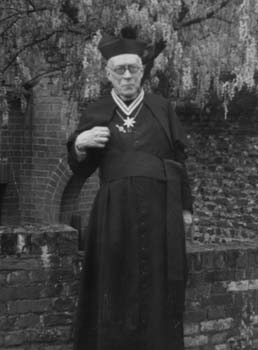
Fr Fynes-Clinton arranged pilgrimages from St Magnus to the shrine at Walsingham (refounded by Fr Hope Patten, intially in the parish church and then in a purpose-built chapel). In 1928 the journal of the Catholic League reported that St Magnus had presented a votive candle to the shrine at Walsingham “in token of our common Devotion and the mutual sympathy and prayers that are we hope a growing bond between the peaceful country shrine and the church in the heart of the hurrying City, from the Altar of which the Pilgrimages regularly start”.
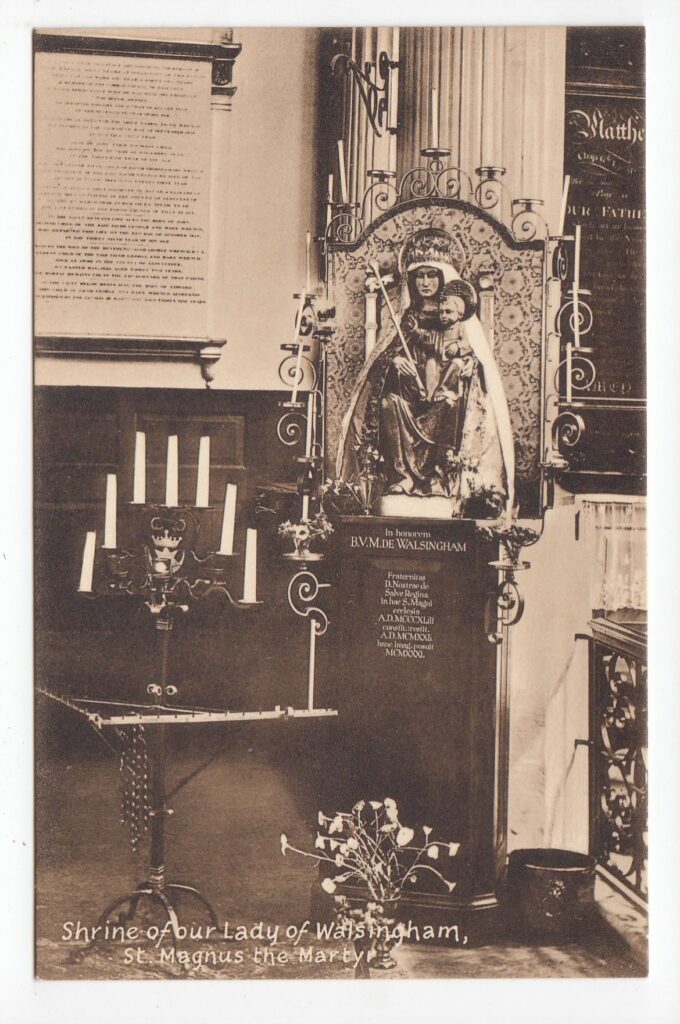
The Fraternity of Our Lady de Salve Regina was was in existence by 1343, having been founded by the “better sort of the Parish of St Magnus” to sing the anthem Salve Regina every evening. It received a bequest in 1349 from the will of Roger Cloville and at least eight further bequests during its first century. Five wax lights were burned at the time of the singing of the anthem in honour of the five principal joys of Blessed Virgin Mary.
The singing of Salve Regina, whether in chant or in polyphony as a votive antiphon, has been described by Professor Magnus Williamson as “the emblematic musical form of late-medieval Catholicism”. It was inspired by “the formal adoption of the doctrine of purgatory, which stimulated the foundation of chantries, and the consolidation of Marian piety, exemplified and promoted by the mendicant orders”. The Salve Regina was traditionally sung at the end of Compline (Night Prayer) and was prescribed for universal use by Pope Gregory IX in 1239 (see the reference in Dante’s Divine Comedy, Purgatorio VII, completed in 1320). Over time the anthem became part of a separate Salve service (Salut in France, Lof in the Low Countries), the evening devotions of confraternities across Europe. In books of hours, primers for the laity who wished to incorporate elements of monasticism into their devotional life, the Salve Regina and associated collect appeared after Compline in the Officium parvum beate Marie Virginis (Little Office of the Virgin) until Henry VIII’s break with Rome in 1534, sometimes with an illustration of the Assumption or Coronation of Mary.
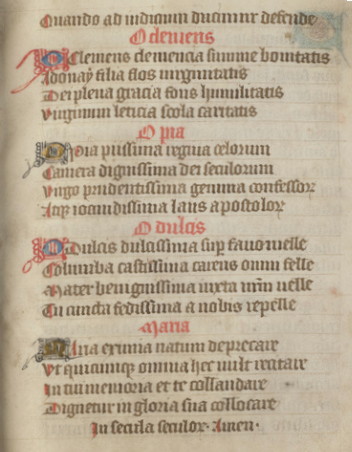
The Guild certificates of 1388/89 record that the Confraternity of Salve Regina and the guild of St Thomas the Martyr in the chapel on the bridge, whose members belonged to St Magnus parish, had some years earlier determined to become one, to have the anthem of St Thomas after the Salve Regina and to devote their united resources to restoring and enlarging the church of St Magnus. Letters patent were granted to the Fraternity of St Mary and St Thomas the Martyr of Salve Regina in St Magnus on 26 May 1448.
Geoffrey Chaucer, whose family home was near the bridge in Thames Street, may be referring to the Fraternity in the General Prologue of The Canterbury Tales when he mentions five guildsmen “clothed alle in o lyveree of a solempne and a greet fraternitee”. Certainly the Second Nun’s Prologue draws on images from the Salve Regina:
Now help, thow meeke and blisful faire mayde,
Me, flemed wrecche, in this desert of galle;And though that I, unworthy sone of Eve,
Be synful, yet accepte my bileve.O thou, that art so fair and ful of grace,
Be myn advocat in that heighe place
The Fraternity was dissolved on Easter Day 1548 under the Abolition of Chantries Act 1547, the royal commissioners appointed to survey chantries recording the annual income and expenditure of the fraternity as follows:
Yearly income: £49 16s 8d p.a. from gifts of Andrew Hunte, Thomas Broke, John Wage, John Parnell, Henry Hale and John Potman. Of which, £8 to Sir William Swanne, priest; £8 to William Buntinge, priest; £10 4s 1½d obits, lamps and lights; 15s quitrents to the Bridgehouse; 10s to St Bartholomew’s Hospital, Smithfield; £1 0s 8d to the poor; 5½d to the sheriffs of London for socage money; £5 4s to Thomas Atkynson, a brother of the fraternity in prison at Ludgate, at 2s per week; £2 18s 4d to father Woodhouse, a blind brother, at 1s 2d per week for his lifetime; £2 3s 4d to [blank] Kethers, a sister ‘fallen in decay and sick of the palsy’, at 1s per week for her lifetime; £8 13s 4d to Marchaunt’s widow, Dyxover’s widow, Swanne’s widow and Martyson’s wife: sisters ‘fallen in poverty and making their suit to them’, at 10d per week for their lifetimes, according to the foundation. Total deductions £47 9s 3½d. Clear remainder £2 7s 4½d p.a.
The 1549 Book of Common Prayer combined the offices of Vespers and Compline into the service of Evening Prayer (Evensong). This, of course, omitted a closing Marian antiphon but included the rubric “In Quires and Places where they sing, here followeth the Anthem”. Some in the Church of England continued to use the traditional hours for private devotions, most notably Bishop John Cosin, whose A Collection of Private Devotions of 1627 went through many editions, Nicholas Ferrar and the community at Little Gidding in the 17th century, and John Henry Newman, who encouraged their use in Tract 75 On the Roman Breviary as embodying the substance of the Devotional Services of the Church Catholic (1836). Benediction of the Blessed Sacrament following Evensong was introduced in Anglo-Catholic churches following the Oxford Movement. Compline was restored to the Church of England’s liturgy as a separate office in the 20th century and an anthem to the Blessed Virgin Mary after Compline is provided for in the Divine Office of the Ordinariate of Our Lady of Walsingham.
As recorded above, the Fraternity was refounded in 1922, the year in which TS Eliot published The Waste Land. His poem Ash-Wednesday, which uses Dante’s Purgatorio as a structure, quotes the line “And after this our exile” from the Salve Regina. The fraternity’s badge is shown in the stained glass window at the east end of the north wall of the church above the reredos of the Lady Chapel altar.
Latin text of the Salve Regina and traditional collect:
Salve, Regina, Mater misericordiæ,
vita, dulcedo, et spes nostra, salve.
Ad te clamamus exsules filii Hevæ,
Ad te suspiramus, gementes et flentes
in hac lacrimarum valle.
Eia, ergo, advocata nostra, illos tuos
misericordes oculos ad nos converte;
Et Jesum, benedictum fructum ventris tui,
nobis post hoc exsilium ostende.
O clemens, O pia, O dulcis Virgo Maria.
℣ Ora pro nobis, sancta Dei Genitrix,
℟ Ut digni efficiamur promissionibus Christi.
Oremus
Omnipotens sempiterne Deus, qui gloriosæ Virginis Matris Mariæ corpus et animam, ut dignum Filii tui habitaculum effici mereretur, Spiritu Sancto cooperante præparasti: da, ut cuius commemoratione lætamur; eius pia intercessione, ab instantibus malis, et a morte perpetua liberemur. Per eundem Christum Dominum nostrum.
℟ Amen.
English translation by the Rev Adrian Fortescue (Latin Hymns, 1913):
Hail Holy Queen, Mother of Mercy;
Hail, our life, our sweetness and our hope!
To thee do we cry poor banished children of Eve.
To thee do we send up our sighs,
mourning and weeping in this vale of tears.
Turn then, most gracious Advocate,
thine eyes of mercy towards us;
and after this our exile,
show unto us the blessed fruit of thy womb, Jesus.
O clement, O loving, O sweet Virgin Mary.
℣ Pray for us, O holy Mother of God,
℟ that we may be made worthy of the promises of Christ.
Let us pray
Almighty, everlasting God, who by the co-operation of the Holy Spirit didst prepare the body and soul of the glorious Virgin-Mother Mary to become a worthy dwelling for thy Son: grant that as we who rejoice in her commemoration may, by her loving intercession, be delivered from present evils and from everlasting death. Through the same Christ our Lord.
℟ Amen.
Numerous composers have written polyphonic settings of the Salve Regina hymn over the centuries. Sir Charles Villiers Stanford advised his pupils that Westminster Cathedral offered “polyphony for a penny”, a penny being the price of a bus ride from the Royal College of Music, and in 1915 R.R. Terry commissioned a set of Marian antiphons for the Cathedral choir from Herbert Howells, whose setting of the Salve Regina points stylistically towards his later settings of the Canticles. Francis Poulenc famously included it as the finale of his second opera, Dialogue des carmelites.
Regina Caeli (or, from the Greek vowel format, Coeli) (Queen of Heaven) is an antiphon addressed to the Blessed Virgin Mary which is sung during the Easter season.
Latin text of the Regina caeli:
Regina caeli, laetare, alleluia;
Quia quem meruisti portare, alleluia,
Resurrexit, sicut dixit, alleluia:
Ora pro nobis Deum, alleluia.
℣ Gaude et laetare Virgo Maria, alleluia
℟ Quia surrexit Dominus vere, alleluia
Oremus
Deus, qui per resurrectionem Filii tui, Domini nostri Jesu Christi, mundum laetificare dignatus es: praesta, quaesumus; ut per eius Genetricem Virginem Mariam, perpetuae capiamus vitae aeternae. Per eundem Christum Dominum nostrum. ℟ Amen.
English verse translation:
℣ Joy to thee, O Queen of Heaven. Alleluia!
℟ He whom Thou wast meet to bear. Alleluia!
℣ As He promised hath arisen. Alleluia!
℟ Pour for us to God thy prayer. Alleluia!
℣ Rejoice and be glad, O Virgin Mary, alleluia.
℟ For the Lord is risen indeed, alleluia.
Let us pray
O God, who through the resurrection of your Son our Lord Jesus Christ has
brought joy to the whole world: grant that through His Mother, the Virgin
Mary, we may obtain the joys of everlasting life. Through the same Jesus
Christ our Lord.
℟ Amen.
Latin text of the Angelus
℣ Angelus Domini nuntiavit Mariæ,
℟ Et concepit de Spiritu Sancto.
Ave Maria, gratia plena, Dominus tecum. Benedicta tu in mulieribus, et benedictus fructus ventris tui, Iesus. * Sancta Maria, Mater Dei, ora pro nobis peccatoribus, nunc et in hora mortis nostræ. Amen.
℣ Ecce ancilla Domini.
℟ Fiat mihi secundum verbum tuum.
Ave Maria, gratia plena, Dominus tecum. Benedicta tu in mulieribus, et benedictus fructus ventris tui, Iesus. * Sancta Maria, Mater Dei, ora pro nobis peccatoribus, nunc et in hora mortis nostræ. Amen.
℣ Et Verbum caro factum est.
℟ Et habitavit in nobis.
Ave Maria, gratia plena, Dominus tecum. Benedicta tu in mulieribus, et benedictus fructus ventris tui, Iesus. * Sancta Maria, Mater Dei, ora pro nobis peccatoribus, nunc et in hora mortis nostræ. Amen.
℣ Ora pro nobis, Sancta Dei Genitrix.
℟ Ut digni efficiamur promissionibus Christi.
Oremus
Gratiam tuam, quæsumus, Domine, mentibus nostris infunde; ut qui, Angelo nuntiante, Christi Filii tui incarnationem cognovimus, per passionem eius et Crucem ad resurrectionis gloriam perducamur. Per eundem Christum Dominum nostrum.
℟ Amen.
English translation
℣ The angel of the Lord brought tidings unto Mary
℟ And she conceived of the Holy Ghost
Hail Mary, full of grace, the Lord is with thee, blessed art thou among women, and blessed is the fruit of thy womb, Jesus.* Holy Mary, Mother of God, pray for us sinners, now and at the hour of our death. Amen.
℣ Behold the handmaid of the Lord.
℟ Be it unto me according to thy word.
Hail Mary, full of grace, the Lord is with thee, blessed art thou among women, and blessed is the fruit of thy womb, Jesus.* Holy Mary, Mother of God, pray for us sinners, now and at the hour of our death. Amen.
℣ And the Word was made flesh.
℟ And dwelt among us.
Hail Mary, full of grace, the Lord is with thee, blessed art thou among women, and blessed is the fruit of thy womb, Jesus.* Holy Mary, Mother of God, pray for us sinners, now and at the hour of our death. Amen.
℣ Pray for us, O holy Mother of God.
℟ That we may be made worthy of the promises of Christ.
Let us pray
We beseech Thee, O Lord, pour Thy grace into our hearts; that as we have known the incarnation of Thy Son, Jesus Christ, by the message of an angel, so by His cross and passion we may be brought unto the glory of His resurrection. Through the same Jesus Christ our Lord.
℟ Amen.
Prayer to Our Lady of Walsingham
O Mary, recall the solemn moment when Jesus, thy divine
son, dying on the cross, confided us to thy maternal care.
Thou art our mother, we desire ever to remain thy devout
children. Let us therefore feel the effects of thy powerful
intercession with Jesus Christ. Make thy name again glorious.
Pray, O holy mother of God, for the conversion of England,
restoration of the sick, consolation for the afflicted,
repentance of sinners, peace to the departed.

